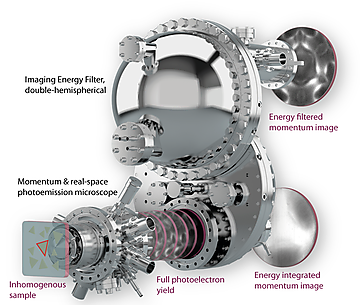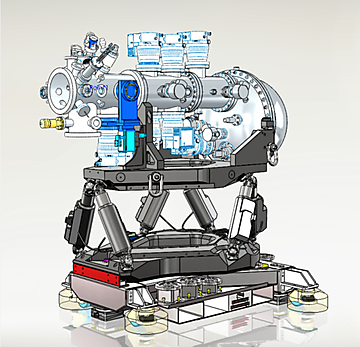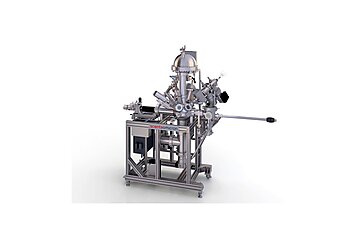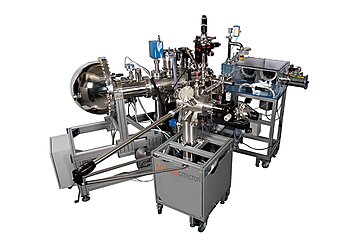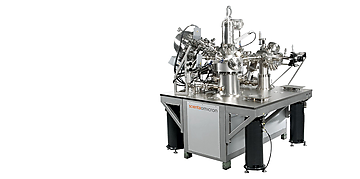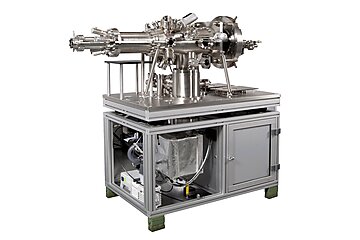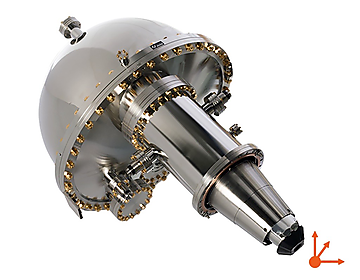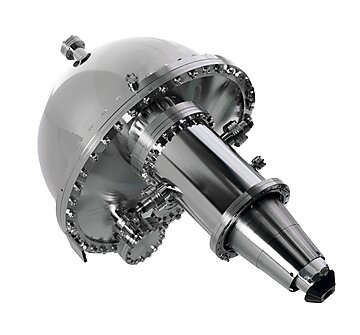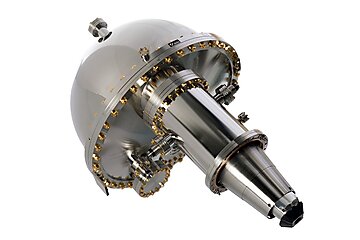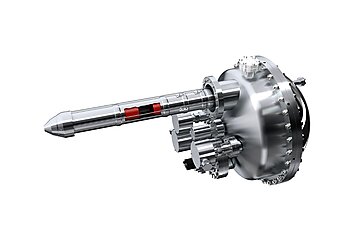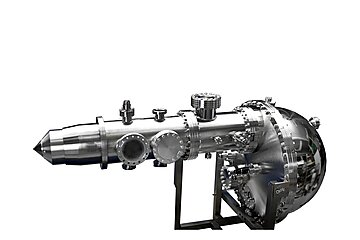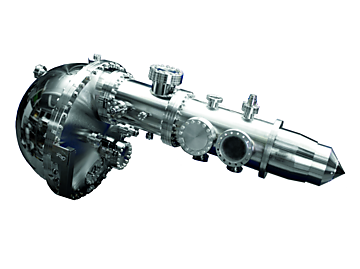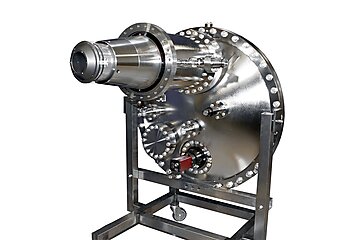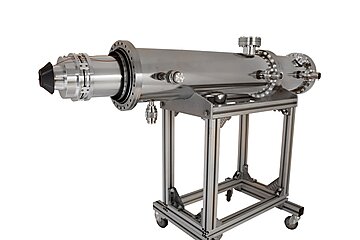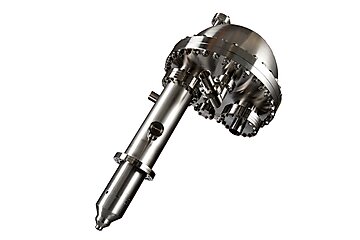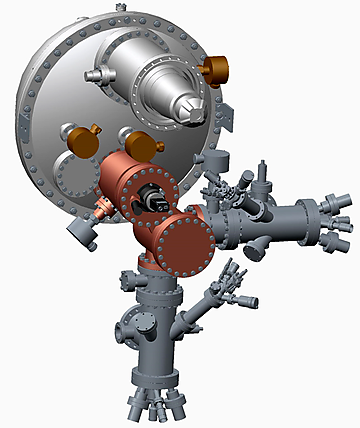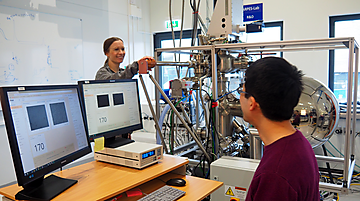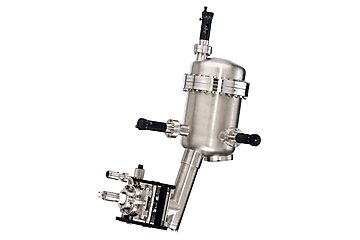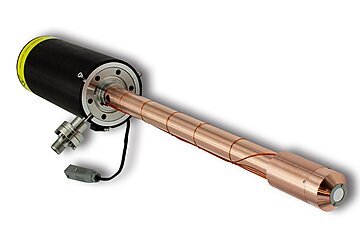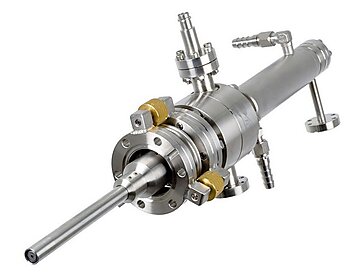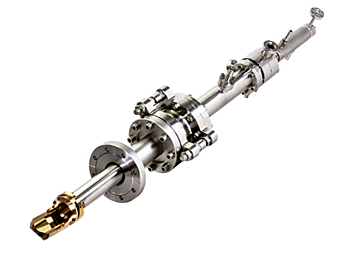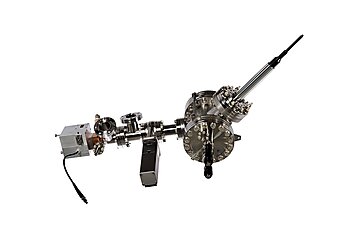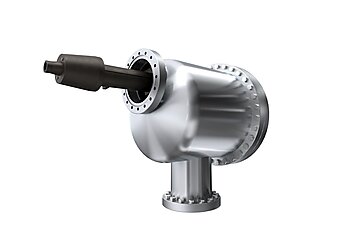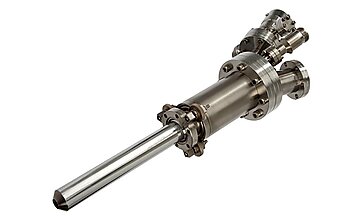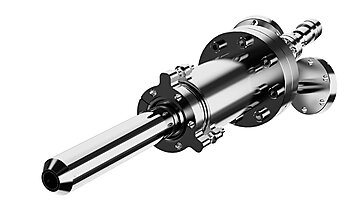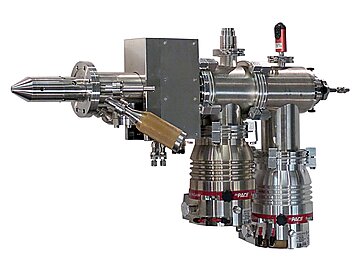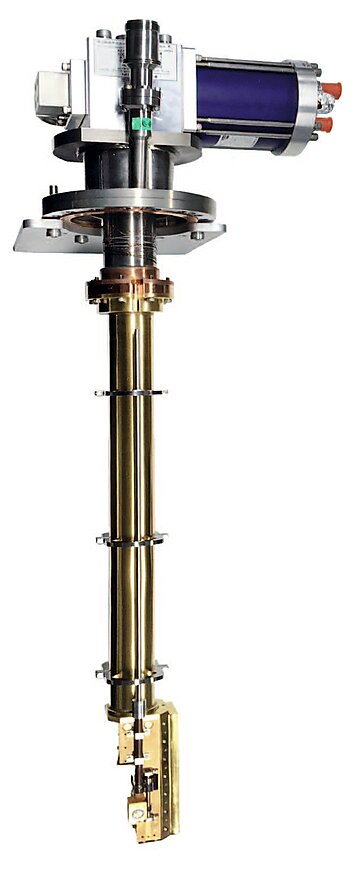Electron Spectroscopy
Electron Spectroscopy Systems
In 1983 – two years after receiving the Nobel Prize – Prof. Kai Siegbahn co-founded Scienta for the continued develoment of electron spectrometers and systems. Since the start, we have been the market leading, most innovative supplier of high-end photoelectron spectrometers.
Please contact us with ideas on how we can develop the future of electron spectroscopy together.
ARPES Lab
Angle-Resolved Photoelectron Spectroscopy (ARPES) has emerged as the most powerful technique to understand the electronic structure of materials and what can influence their physics and chemistry. The ARPES Lab is designed to maximise the advantages gained from the revolutionary DA30-L hemispherical high-resolution analyser with its patented in-lens deflector. The analyser measures the full 3D surface cone of a band-structure without sample tilt.
DeepCore-X
Designed for advanced surface and bulk materials research, DeepCore-X enables high-resolution X-ray Photoelectron Spectroscopy (XPS) and Hard X-ray Photoelectron Spectroscopy (HAXPES) in a single, laboratory-based instrument. With its high-flux Ga Kα MetalJet F-series source (9.25 keV) and the synchrotron-proven EW4000 analyser, DeepCore-X delivers synchrotron-like performance while maintaining ease of use in a compact system. Automation of sample handling, smart workflows, and camera-assisted navigation make DeepCore-X a highly productive and accessible platform for every level of expertise.
NanoESCA
The NanoESCA is an energy-filtering photoemission microscope which can easily switch between the imaging of the momentum space and the real space of photoemission electrons. The wide range of measurement modes makes it predestined for momentum microscopy, ARPES of very localised features and imaging spectroscopy (e.g. with x-ray lab-source or synchrotron).
BAR XPS
It is estimated that up to 90% of chemical products are produced via catalysis. Many heterogeneous catalytic reactions occur at high pressures and temperatures. To study such catalytic reactions, researchers at Stockholm University have constructed an instrument based on Scienta Omicron’s electron spectrometer capable of measuring XPS under conditions of > 1 bar of pressure in the vicinity of the catalytically reactive surface. Through collaboration this capability is available through Scienta Omicron.
XPS Lab
The XPS Lab has been designed to combine outstanding quantitative XPS performance and ease of operation with a modular sample handling concept. This X-ray photoelectron spectrometer can host complementary surface analytical techniques, like AES and UPS, to enhance its characterisation capabilities. The exceptional value of the XPS Lab is based on the high-transmission high-speed Argus CU hemispherical analyser.
HiPP Lab
The HiPP Lab is a state of art ambient pressure photoelectron spectroscopy (APPES) system designed for XPS of solid, gas and/or liquid sample environments under several mbar. It is optimized for speed to result by its stability, simplicity and user friendly design. The system is based on the most modern concepts of APPES, including features like easy accessible chamber, small spot light source and high throughput analyser with swift acceleration mode.
NanoScan Lab
The NanoScan Lab is a versatile tool for surface analysis on the nanoscale. Based on a UHV-version of Zeiss’ Gemini SEM column, there is a wide range of options, such as SEM with Polarization Analysis (SEMPA), focussed ion beam milling (FIB), cathodoluminescence (CL), e-beam lithography (EBL), electron-beam induced deposition (EBID), and energy-dispersive X-ray spectroscopy (EDX).
PEEM Lab
The PEEM Lab is a UHV system with small foot-print tailored for the needs of daily PEEM work. It provides ports for various excitation sources, evaporators a sputter cleaning source and sample heating. In addition, the system is also designed to house a dedicated LHe cooled 4 axis sample stage for PEEM operation below 30K.
Electron Analysers
The electron analyser is a central component in any photoelectron spectroscopy setup. Scienta Omicron offers analysers with outstanding sensitivity and resolution as part of tailored systems and as individual components. Research groups choose our components to build their custom setups located in labs or at synchrotron beamlines across the world. Find the analyser for your application below and contact us for detailed information.
With these analysers, spatially resolved chemical state mapping with XPS is possible even at ambient pressures (APPES) and up to atmospheric pressure. Along with analysers specially developed for hard X-rays (HAXPES), these analysers enable XPS research in the fields of catalysis, liquids, and layered materials such as batteries, solar cells, and semiconductor devices.
Analysers for angular resolved (ARPES) applications enable spin resolved electronic band structure mapping across the surface Brillouin zone. These analysers extend the measurement capabilities for phaenomena such as superconductivity, topological insulators, and other interesting quantum materials for spintronic devices.
DFS30
The DFS30 analyser features ground-breaking Electrostatic 3D Focus Adjustment technology - a major advancement in replacing imprecise mechanical movements with electronic precision and repeatability. This provides significantly improved workflow, speed, and reproducibility when optimizing experimental conditions. High quality ARPES measurements, particularly micro/nanoARPES, require optimised alignment of the photon spot, sample, and analyser focal point. The DFS30 simplifies this alignment with electronic adjustment of the analyser focal point in X, Y and Z (working distance) to the photoelectron emission spot.
DA30-L
Besides XPS and UPS, the DA30-L is especially developed for high quality ARPES measurements. Scienta Omicron´s deflector concept enables full cone angular scans in reciprocal space without sample movement. This allows electronic band structure mapping, even spin resolved, of the full surface Brillouin zone without changing measurement geometry, eliminating matrix element effects, and simplifying the interpretation of results dramatically.
DA30-L-8000
The DA30-L-8000 analyser is a progression of the DA30-L analyser optimised for ultra-high resolution at low kinetic energies. Combined with Scienta Omicron´s deflector concept electronic band structure mapping of the full surface Brillouin zone without changing measurement geometry is possible. These are the models of choice for ARPES measurements below 3 eV kinetic energy with high demands for energy resolution.
DA20
The DA20 provides ARPES as well as XPS and UPS while maintaining a compact footprint. The DA20 includes the ground-breaking deflection technology that was previously only available in the larger DA30-L analyser models, enabling full cone ARPES measurements without sample rotation. This allows electronic band structure mapping of the surface Brillouin zone without changing measurement geometry, eliminating matrix element effects, and simplifying the interpretation of results dramatically.
HiPP-2
The Scienta Omicron HiPP-2 analyser is developed for high pressure photoelectron spectroscopy (APPES) as well as hard x-ray photoelectron spectroscopy (HAXPES). This state-of–the-art analysis tool enables angle-resolved photoemission at ambient pressures up to 50 mbar and kinetic energies up to 10 keV, as well as the combination of the two.
HiPP-3
The HiPP-3 analyser features state-of-the-art technology for outstanding imaging XPS at ambient pressures (APPES), with a spatial resolution better than 10 μm. In addition, the unique Swift Acceleration Mode enables unparalleled transmission, with count rates improved by up to a factor of 10.
EW4000
The EW4000 electron analyser is a state-of-the-art and widely used electron analyser for HAXPES. It is also one of the key parts is Scienta Omicron’s HAXPES Lab. Expanding the parallel angular detection range to 60° in the full range from UPS via XPS to HAXPES gives great possibilities for high transmission measurements as well as novel Standing Wave and XPD experiments.
ARTOF-2
The Scienta ARTOF 10k analyser marked a revolution in the field of angle-resolved photoelectron spectroscopy (ARPES) for pulsed photon sources with its parallel full cone detection and unchallenged transmission. The Scienta ARTOF-2 is a further development of the concept especially for sources generating harmonics and kinetic energies above 10 eV.
Argus CU
The Argus CU analyser offers outstanding sensitivity, simple handling and maximum convenience during your XPS measurements. In addition, the Argus CU is accurately characterised for quantification and allows spectroscopy with excellent snapshot performance also when operated with large apertures.
3D Spin VLEED
The 3D Spin VLEED utilises the exchange scattering mechanisms to be 50x more efficient than Mott schemes. It is equipped with Ferrum VLEED detectors which mount on a proprietary transfer lens with high speed switching between channels. The DA30-L's unique deflection mode directs any part the full acceptance cone to the spin detectors without sample rotation for detection of in-plane and out-of-plane spin vectors.
PEAK
PEAK is designed to control acquisition of photoelectron spectra with Scienta Omicron analysers. With its modern software architecture, PEAK offers improved performance for data acquisition, workflow, and live visualisation of data. The modular design and the modern network-based application programming interface (API) facilitate integration of additional equipment as well as full integration of the analyser in external control systems.
Photon Sources
Scienta Omicron offers a range of high performance, well-established X-ray and UV photon sources. All sources are available as standalone components or as fully integrated parts of system solutions. Excellent stability, easy operation and robust design enables high up-time and great research results.
Find the source for your application below and contact us for detailed information.
XM1000
The XM1000 monochromated X-ray source provides optimum photon flux and excellent energy resolution. In addition, low background and the absence of satellites are key advantages of the XM1000 over non-monochromated X-ray sources. Narrow core level peaks and low background simplifies identification of the surface chemistry by XPS and other X-ray spectroscopy applications.
DSX400
The DSX400 provide high flux X-ray radiation which enables intense photoelectron spectra. The dual anode makes it possible to change excitation energy without breaking vacuum and thus quickly verify measured data. The X-ray tube is designed with a narrow nose cone which ensures a short source-to-sample distance, also when combined with other techniques.
HIS 13 UV Source
The HIS 13 is a flange mounted and easy to integrate vacuum ultraviolet photon source for standard and advanced photoelectron spectroscopy applications.
HIS 14 HD UV Source
The HIS 14 HD VUV light source is ideally suited for ultraviolet photoelectron spectroscopy experiments which require small excitation area (ARPES) and high photon flux (PEEM).
VUV5k
The Scienta Omicron VUV5k is a well-established high intensity narrow bandwidth UV source for excellent and efficient UPS and ARPES measurements. The microwave-driven source generates a very intense and well confined He plasma. With the UV monochromator tuned to a selected wavelength from the He plasma, the VUV5k yields intense narrow-band monochromatic UV light at the sample. To enable continuous and long experiments the VUV5k has excellent stability and requires only minimal maintenance.
Ion & Electron Sources
Scienta Omicron offers a selection of Ion and Electron Sources to suit a range of applications from sample cleaning and depth profiling.
We also offer a variety of electron sources for tailored system solutions and for research groups which build custom setups based on components. Our offering includes electron sources suitable for scanning electron microscopy (SEM) and acquisition of Auger data when combined with a suitable energy analyser.
In addition, we offer a monochromated electron source in combination with our 2D analysers enabling high resolution electron energy loss spectroscopy (HREELS). HREELS is a surface sensitive technique and used to characterise vibrations of adsorbed species, surface phonons, and plasmons.
Find the source for your application below and contact us for detailed information.
MCES150
The MCES150 is a collimated and monochromatic electron source with an extremely narrow energy distribution. This type of source forms the base for a high resolution electron energy loss spectroscopy (HREELS). The combination with a Scienta Omicron high resolution ARPES analyser creates an efficient platform for vibrational spectroscopy and phonon dispersion measurements.
FDG 150
The FDG 150 is a differentially pumped fine-focus ion source suitable for XPS and AES depth profiling, sputter cleaning and charge neutralisation with slow, positively charged ions. Advanced features like a regulated gas inlet, keystone correction, intermediate acceleration of slow ions set the FDG 150 apart from other depth profiling sources.
FDG 15
The FDG 15 ion source is designed to clean samples for surface analysis, to perform simple depth profiling, to act as an excitation source for ISS/LEIS experiments and optionally to provide slow ions (<15 eV), e.g. for charge neutralisation in ESCA.
GCIB 10S
We offer the complete range of substrate preparation systems, including MBE, PLD, Sputtering and other techniques. Each thin film solution is prepared to and can be easily upgraded with more than 30 support techniques in-situ surface analysis. This system is designed to fulfil the highest and most stringent requirements of modern thin film deposition.
Sample Manipulators
When aiming at high experimental energy resolution it is crucial to achieve ultra-low sample temperatures. This is possible with these state-of-the-art cryo manipulators featuring upto 6 fully motorized axes for a large range of movements.
Open Cycle Sample Manipulators
These state-of-the-art cryo manipulators have proven ARPES performance and have 4 to 6 motorized axes. These open cycle manipulators reach the lowest possible temperatures for high experimental energy resolution, are free from vibrations, while maintaining extremely low liquid Helium consumption. With fast temperature ramps and numerous options these cryo manipulators cover a complete range of experiments.
Closed Cycle Sample Manipulators
These state-of-the-art cryo manipulators have proven ARPES performance and have 4 to 6 motorized axes. The closed cycle cryo manipulators have no liquid Helium consumption providing unlimited holding time and low operating costs while offering the lowest temperatures needed for high experimental energy resolution. With numerous options these cryo manipulators cover a complete range of experiments.



